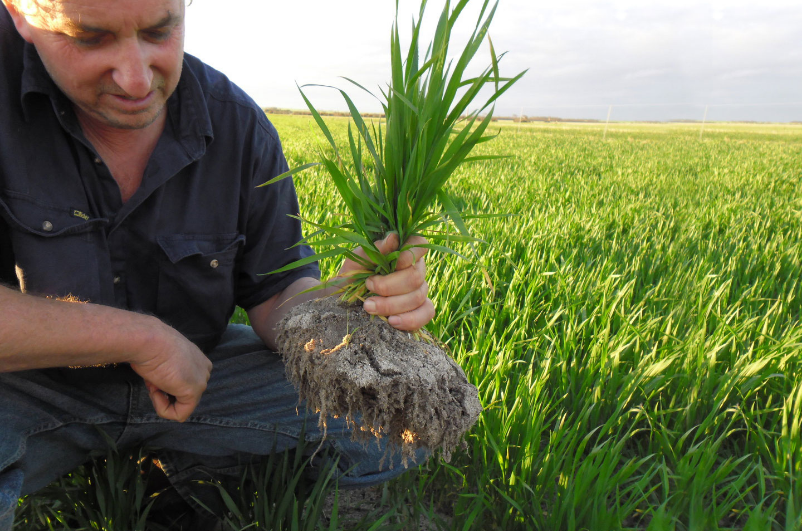TEN STEPS TO
BIOLOGICAL FARMING
These steps have been put together using information from the Biological Farming Roundtable resource group. This group studies papers and articles from scientists, farmers and great biological thinkers and workshop how these concepts can be put into practice on farm.

01.
FEED AND PROTECT THE MICROBES IN YOUR SOIL
- Use NutriSoil to increase your plants photosynthetic efficiency. Plant exudates created from photosynthesis feed microbes which will increase and diversify. A balance of microbial types will ensure the soils ecosystem has an ability to self- function. Plant exudates send chemical signals to microbial communities to engage microbes that are specific to helping that species grow and thrive.
-
Keep dry litter on your ground. This could be in the form of stubble from crops, dry summer grasses, maintaining grazing height or litter from slashing grasses (green manure). This will:
- protect microbes from hot dry conditions
- feed microbes
-
decompose to build soil carbon
- Add worm castings, manure or compost to return nutrient to the soil, provide food for and stimulate existing microbes.
02.
MAXIMISE GREEN GROUNDCOVER ALL YEAR ROUND
- In a cropping system; keep stubble and allow weeds to grow over summer. Grow as much ground cover in a non-crop phase as possible. Leaving soils in fallow (bare) over summer, exposes microbes to hot conditions and removes their food source which is derived from photosynthesising plants. Non crop phases that retain the weeds prior to sowing will build soil carbon and water holding capacity for the next crop. The weeds will NOT take water from the soil, they will build the water holding capacity in the soil.
- In hot dry conditions select plant species that are dormant in summer but have the ability to respond to rain. This will minimise the risk of planting summer active pastures that will not survive in minimal rainfall. As organic matter builds in soil, water holding capacity will increase and maintaining summer active species will be more achievable.
- Plant a cover crop in between crop phases; the fertility built will out way the cost of planting the cover crop and may also serve as food for livestock.
- Try pasture cropping where cereal crops are sown directly into perennial pastures. This allows for constant green ground cover and all year round soil carbon building capacity.
- In a cropping system summer crops and cover crops will, over time, assist with reducing herbicide use and begin to address herbicide resistant species problems. Consider using warm and cool season species, broad leaves and grasses in each mix. e.g. Wheat (a cool season grass), Cowpeas (a warm season broadleaf), some sunflowers (a warm season broadleaf), and Millet– a warm season grass.
- Plant a variety of clovers in crop rotation phases. This will assist with nitrogen fixation and maximising green ground cover.
03.
REDUCE HIGH INPUT SYNTHETIC FERTILISERS AND CHEMICAL TREATMENTS
04.
ENCOURAGE DIVERSITY RATHER THAN MONOCULTURES
- Choose a good flowering species in pastures and cover crops – one that will attract pollinators and be a home for the predator insects to warn off unwanted pests.
05.
ENCOURAGE BENEFICIAL INSECTS AND BIRDS
- If pasture cropping, plant as many different varieties as feasible e.g. 5 or up to 20. Different plant varieties attract different insects and microbes. They also provide a variety of root structures for oxygen channels and water filtration opportunities in the soil.
- Plant crops in-between rows of orchards, encourage native grasses, flowering plant species and shrubs between or surrounding crops.
06.
SUPPORT AND PROTECT WATERWAYS FROM CHEMICAL LEAKAGE
Healthy waterways attract beneficial insects and flora and keep water clean for stock and irrigation usage. Keep fertiliser leeching to a minimum. Plants only need a whiff of Nitrogen to prime a healthy biological system. Applying large amounts of Nitrogen will cause leaching into waterways, as does over-application of Superphosphate, MAP and DAP.
07.
INTRODUCE ANIMALS INTO THE SYSTEM TO GRAZE AND FERTILISE
Learn to use your stock. Many farmers find the biggest jump in soil health begins when they start mob grazing. Grazing creates flushes of plant exudates to flow which stimulate the microbes. Think of stock as four legged microbial digesters that will fertilise your pastures and crops in the non-crop phase.
08.
DON’T DO THINGS JUST BECAUSE YOU ALWAYS HAVE
-
Question your need to drench animals. Stock grazing on a healthy fertile soil may not need drenching which excretes unwanted chemical back into your soil through manure and urine.
- Question your need for a fungicide seed treatment. Once soil fertility has increased and chemical fertilisation has decreased, sow a trial area without the seed treatment. Use NutriSoil to coat the seed in beneficial microbes, nutrient and humus. Monitor your trial.
09.
MINIMISE SOIL DISTURBANCE WHERE POSSIBLE
Be smart about your machinery passes and traffic on soil. Compaction works against soil microbes by creating anaerobic conditions where non beneficial microbes can dominate. Research what type of tillage is needed, over tillage can lead to loss of topsoil and physical structure of the soil.
10.
THINK HOLISTICALLY, IT’S ALL CONNECTED
Be mindful that one small change can effect one thousand other changes in the soils ecosystem. These changes may not be apparent immediately, but experience has now taught us, it will happen. Listen to your intuition, if you are uncomfortable about a particular action you’re going to take on the soil – is there another way of achieving your goal? While we are always learning about the soil and doing our best to keep our inputs smart, Mother Nature will always have final say. A smart farmer will respect and work with the soil instead of trying to control it with excessive artificial inputs.



